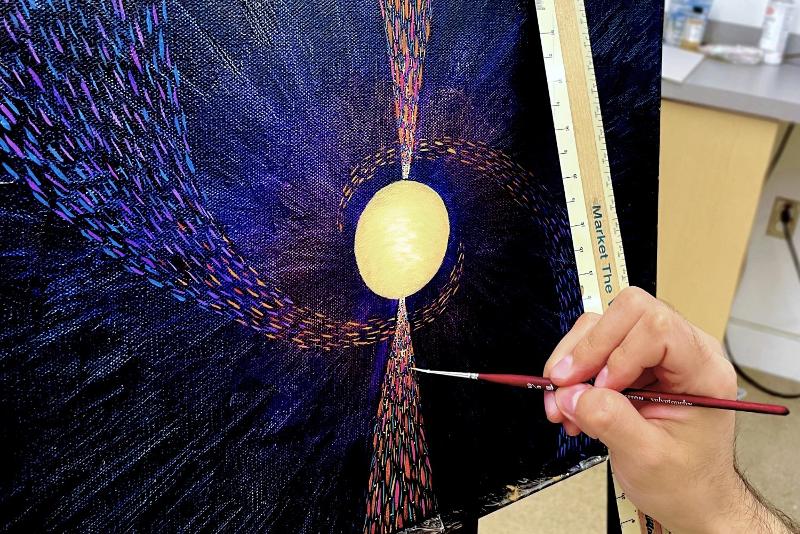In a world where art and science are often seen as opposites, a group of forward-thinking individuals at MIT is breaking down barriers and exploring the powerful intersection of creativity and research. Join us on a journey as we delve into the innovative course, 'Making Art for Scientists: Materials, Processes and Information Relay,' offered by MIT Arts Studios. Through this course, scientists and engineers are discovering new ways to visualize and represent their research, transforming abstract ideas into captivating works of art that convey insights beyond raw data.
Unlocking the Creative Potential: Art and Science Collide
Discover how the course 'Making Art for Scientists' is revolutionizing the way scientists and engineers approach their research.
Art and science have long been viewed as separate disciplines, but at MIT, these boundaries are being shattered. The course 'Making Art for Scientists' is providing a platform for scientists and engineers to explore their research through the lens of art. By merging creativity and scientific inquiry, participants are uncovering new insights and perspectives that traditional research methods may overlook.
Through this course, students are learning to visualize and represent their research in innovative ways. They are discovering that art can serve as a powerful tool for communication, allowing complex concepts to be conveyed in a more accessible and engaging manner. By embracing art as a means of expression, scientists and engineers are expanding the boundaries of their disciplines and fostering a deeper connection between creativity and research.
The Transformative Power of Art: From Data to Artwork
Explore how art can transform abstract data into meaningful and impactful visual representations.
Raw data can often be overwhelming and difficult to comprehend. However, through the process of creating art, scientists and engineers are able to distill complex information into visually stunning representations. By translating data into artwork, they are able to convey insights and narratives that may not be immediately apparent from the raw data alone.
Art provides a unique perspective that allows viewers to engage with scientific concepts on a deeper level. It bridges the gap between technical jargon and everyday understanding, making research more accessible and relatable. Whether through paintings, animations, or digital art, the transformative power of art enables scientists and engineers to communicate their findings in a way that resonates with a wider audience.
Inspiration from Artistic Exploration: Broadening Research Horizons
Discover how artists' works inspire scientists and engineers to think differently about their research.
Artists have a unique way of exploring and interpreting the world around them. By immersing themselves in the works of other artists, scientists and engineers gain new perspectives and insights that can inform their own research. The course 'Making Art for Scientists' exposes participants to a diverse range of artistic styles and techniques, encouraging them to think outside the box and approach their research from a fresh perspective.
Through this artistic exploration, scientists and engineers are able to break free from the constraints of traditional research methods and embrace creativity as a driving force. They learn to think critically, experiment with new ideas, and push the boundaries of their disciplines. By integrating art into their research process, they are able to unlock new avenues of innovation and make groundbreaking discoveries.
Blurring Boundaries: The Synergy of Art and Science
Explore the symbiotic relationship between art and science, and how they can inspire and inform each other.
Art and science are often seen as opposites, but in reality, they are two sides of the same coin. Both disciplines rely on curiosity, creativity, and a deep desire to understand the world around us. The course 'Making Art for Scientists' encourages participants to embrace the synergy between art and science, recognizing that they can inspire and inform each other in profound ways.
Artists have long drawn inspiration from scientific concepts, using them as a springboard for their creative endeavors. Similarly, scientists and engineers can benefit from the artistic process, gaining new insights and perspectives that can enhance their research. By blurring the boundaries between art and science, we can foster a culture of innovation and collaboration that pushes the boundaries of human knowledge.
Conclusion
The course 'Making Art for Scientists: Materials, Processes and Information Relay' at MIT Arts Studios is revolutionizing the way scientists and engineers approach their research. By merging art and science, participants are able to unlock new insights, communicate complex ideas, and push the boundaries of their disciplines. Through the transformative power of art, abstract data is transformed into captivating visual representations that resonate with a wider audience.
By embracing the synergy between art and science, we can foster a culture of innovation and collaboration that propels us towards new discoveries and breakthroughs. The intersection of creativity and research holds immense potential, and at MIT, we are harnessing that potential to shape the future of science and technology.
FQA
How does art enhance scientific research?
Art enhances scientific research by providing a unique perspective and visual representation of complex data. It allows researchers to communicate their findings in a more accessible and engaging manner, bridging the gap between technical jargon and everyday understanding.
Can art inspire scientific breakthroughs?
Yes, art can inspire scientific breakthroughs by offering new perspectives and insights. Artists often explore and interpret the world in ways that scientists may not consider, leading to innovative approaches and discoveries in research.
What are the benefits of merging art and science?
Merging art and science allows for interdisciplinary collaboration, fostering creativity, and pushing the boundaries of traditional research methods. It encourages scientists and engineers to think outside the box, experiment with new ideas, and unlock new avenues of innovation.

